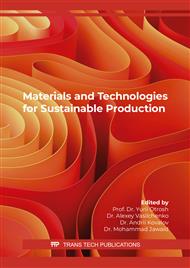[1]
Pattnayak, P.K. Misra, M.K. Energetic and economics of traditional gur preparation: A case study in Ganjam District of Orissa, India. Biomass & Bioenergy. 26 (2004) 79-88.
DOI: 10.1016/s0961-9534(03)00061-8
Google Scholar
[2]
Jagannadha Rao, P.V.K. Madhusweta, Das. Das, S.K. Jaggery- A Traditional Indian Sweetener. Ind. J. Tradit. Knowl. 6 (1) (2007) 95-102.
Google Scholar
[3]
Sahu, A.P. Paul, B.N. The role of dietary whole sugar- jaggery in prevention of respiratory toxicity of air toxics and in lung cancer. Toxicol. Lett. 95 (1) (1998) 154.
DOI: 10.1016/s0378-4274(98)80615-2
Google Scholar
[4]
Jagannadha Rao, P.V.K. Madhusweta, Das. Das, S.K. Effect of moisture content on glass transition and sticky point temperatures of sugarcane, palmyra-palm and date-palm jaggery granules. Int. J. Food Sci.Technol. 45 (2010) 94-104.
DOI: 10.1111/j.1365-2621.2009.02108.x
Google Scholar
[5]
Vengaiah, P.C. Ravindrababu, D. Murthy, G.N. Prasad, K.R. Jaggery from palmyra palm- present status and scope. Ind. J. Tradit. Knowl. 12 (4) (2013) 714-717.
Google Scholar
[6]
Mathur, K.N. Khanna, M.L. Application of solar energy to small scale industries. Sol. Energy. 1 (1) (1957) 34.
DOI: 10.1016/0038-092x(57)90053-1
Google Scholar
[7]
Das, S. Palm gur industry-Key to rural economy. Orissa Review, (2004)18-20.
Google Scholar
[8]
http://orissagov.nic.in/e-magazine/Orissareview/Sept2004/englishPdf/sep04.pdf.
Google Scholar
[9]
Bakshi, P. Sinha, A. Basu, D. Indigeneous technical knowledge in processing off date palm juice and its implications on livelihood in Nadia district of West Bengal. J. Crop. Weed. 16(2) (2020) 130-134.
DOI: 10.22271/09746315.2020.v16.i2.1326
Google Scholar
[10]
Rangaswami, G. Palm tree crops in India. Outlook. Agric. (UK), 9(4) (1977) 167-173.
DOI: 10.1177/003072707700900404
Google Scholar
[11]
Chockalingam, C. Gur manufacture in Tamil Nadu- A review, Proceedings of national seminar-cum-group discussion on jaggery manufacture and storage, Lucknow, 95 (1985).
Google Scholar
[12]
Jagannadha Rao, P.V.K. Das, S.K. Das, Madhusweta. Moisture sorption isotherms of sugarcane, palmyra-palm and date-palm jaggery. In: Proceedings of American Society of Agricultural and Biological Engineers Annual International Meeting (paper no. 063007), Portland, Oregon, 9-12th July (2006).
DOI: 10.13031/2013.20851
Google Scholar
[13]
Pandey, J. P. Report on engineering properties of sugarcane juice concentrated syrup and jaggery. Department of Process and Food Engineering, Pantnagar, India, (2001).
Google Scholar
[14]
Tiwari, G.N. Om, Prakash. Subodh, Kumar. Evaluation of convective heat and mass transfer for pool boiling of sugarcane juice. Energy. Convers. Manag. 45 (2004)171-179.
DOI: 10.1016/s0196-8904(03)00143-2
Google Scholar
[15]
Jagannadha Rao, P.V.K. Das, Madhusweta. Das, S.K. Thermophysical properties of sugarcane, palmyra-palm and date-palm granular jaggery. Int. J. Food. Prop. 11 (2008) 876-886.
DOI: 10.1080/10942910701671281
Google Scholar
[16]
Jagannadha Rao, P. V. K. Madhusweta, Das. Das, S.K. Changes in physical and thermo-physical properties of sugarcane, palmyra-palm and date-palm juices at different concentrations of sugar. J. Food Eng. 90 (2009) 559-566.
DOI: 10.1016/j.jfoodeng.2008.07.024
Google Scholar
[17]
Jagannadha Rao, P.V.K. Madhusweta, Das. Das, S.K. Effect of anti-caking agents on moisture sorption isotherms of palmyra-palm jaggery granules. Int J Proc Post Harvest Technol. 8 (2) (2017)113-122.
DOI: 10.15740/has/ijppht/8.2/113-122
Google Scholar
[18]
Nighitha, M.T. Sudagar, I.P. Engineering Properties of Palmyra-palm Jaggery. Trends Biosci. 10 (43) (2017) 8974-8976.
Google Scholar
[19]
Deotale, S. Bhotmange, M.G. Halde, P. Chitale, M. Study of traditional Indian sweetener Jaggery, and its storage behavior. Int. J. Chem. Stud. 7(3) (2019). 410-416.
Google Scholar
[20]
Myers, R.H. Response surface methodlogy. Boston, MA: Allyan and Bacon (1971).
Google Scholar
[21]
Sandanasamy, J. Yusoff, M.M. Gimbun, J. Optimization of Ultrasonic-Assisted Extraction of Polyphenolic and Flavonoids from Labisia pumila. In Materials Science Forum. 890 (2017) 167-170.
DOI: 10.4028/www.scientific.net/msf.890.167
Google Scholar
[22]
Anonymous, Stat-Ease Version 13. East Hennepin Avenue, Suite 480, Minneapolis, MN 55413, USA: Stat-Ease, Inc (2021).
DOI: 10.1002/cem.820
Google Scholar
[23]
AOAC. Official methods of analysis. Washington DC, USA: Association of Official Analytical Chemists (1998).
Google Scholar
[24]
Linden, G. Methods of particle size analysis. In Analytical Techniques for Foods and Agricultural Products; Melcion J.P., and Monredon, F.De., (Eds.), VCH Publishers: New York, First Edition, (1996) pp.229-248.
Google Scholar
[25]
Anonymous, Microsoft Office Professional Edition 2013. Microsoft Office Excel. One Microsoft Way, Redmond, WA 98052-6399, USA: Microsoft, Inc (2013).
DOI: 10.1007/978-1-4302-6689-1_4
Google Scholar
[26]
Anonymous, Origin. 2017. Non-Linear Curve Fit. Ver.6.1. Northampton, MA 01060, USA: Origin Lab, Inc (2017).
Google Scholar


